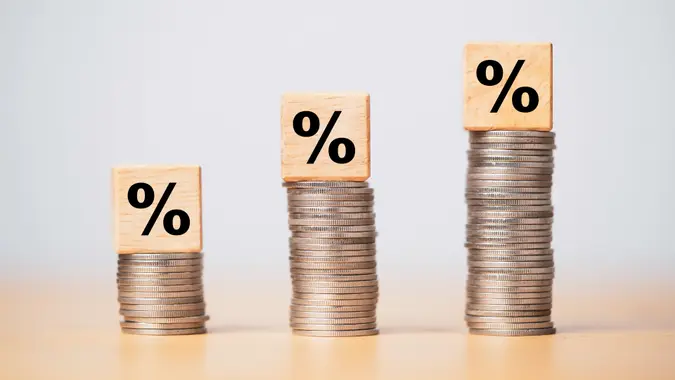How Much Interest on $1 Million Dollars Can You Earn?

Commitment to Our Readers
GOBankingRates' editorial team is committed to bringing you unbiased reviews and information. We use data-driven methodologies to evaluate financial products and services - our reviews and ratings are not influenced by advertisers. You can read more about our editorial guidelines and our products and services review methodology.

20 Years
Helping You Live Richer

Reviewed
by Experts

Trusted by
Millions of Readers
A million dollars is often tossed about as the dream figure for a retirement account. If you’ve managed that, congratulations! Many Americans, however, come up well short. What’s the real power of having $1 million, though? What can you do with it? Once you reach the $1 million plateau, you’ll generally have three options: spend, save or invest.
While blowing through $1 million sounds like a lot of fun, it’s not financially responsible. Saving it can be a good option, especially in an era where you can earn 5% or more on a high-yield savings account, but it doesn’t compare to how much you could make from smart investing. Simply investing in the S&P 500 alone averages a whopping 10% yearly return.
That’s why investing for the long term is the best option for building lifelong wealth. The longer you keep it invested, the more time you have for your interest to compound, meaning you’ll earn interest upon your interest. So, with that in mind, exactly how much interest does $1 million earn? Could you spend your golden years living off just those returns?
Here’s a deeper dive.
How To Calculate the Yearly Interest on $1 Million
How much interest does $1 million make per year? On average, investors can expect about a 10% annual return on the S&P 500 — that’s $100,000 per year, provided you reinvest at least some of the dividends.
However, your return depends on several different factors. Your time horizon, the type of investment you make and the risk associated with that investment will all affect the interest earned on your million-dollar bank account.
Here are some of the ways you can build interest on your $1 million and how much you might earn, according to the most recent data from the FDIC.
High-Yield Savings Accounts
A high-yield savings account allows you to safely store your money as it earns more interest than a traditional savings account. Your money is also insured by the FDIC for up to $250,000 per depositor, per bank.
According to the FDIC, high-yield savings accounts offer interest rates of around 4% to 5%. That means if you put the entire $1 million into that savings account, you’re looking at a yield of $40,000 to $50,000 per year.
Certificates of Deposit
A CD is another safe, FDIC-insured way to invest your money. CDs earn interest over a set term, and you cannot withdraw — at least without penalty — until it reaches its maturity date. Interest rates on a CD can run around 3.5% to 5%. Using that example, $1 million earns $35,000 to $50,000 a year, according to a simple compound interest calculator.
Money Market Account
The average annual interest rate on a money market account falls between 0.01% APY and 3.45% APY, depending on your balance. For example, if your APY is 0.45%, you’re looking at earning an additional $4,500 from your $1 million.
Mutual Funds
There are thousands of mutual funds, so your average return over time can vary greatly. A short-term government bond fund might average 3% to 6% yearly, while an S&P 500 index fund might post an average return closer to 10% annually. When picking a mutual fund, it’s important to match your investment objectives and risk tolerance with the fund.
Over the long run, mutual funds might provide you with $30,000 to $100,000 or more annually, depending on the fund’s success and the risk you’re willing to accept.
Treasury Bonds or Notes
A relatively safe parking place for that cool million would be U.S. government debt, in the form of Treasury bonds, bills or notes. The amount of interest returned on these investments varies. For example, if a 20-year Treasury bond yielded 4.625%, as it did in January 2025, this would mean you would earn $46,250 a year for a $1 million investment. A 30-year T-bond yielding 4.50% would pay $45,000 annually.
Although not guaranteed, U.S. government debt is among the safest possible investments. The debt is backed by federal taxes and other government income.
Municipal Bonds
A step up the yield ladder is state and municipal bonds. These are debts issued by public agencies for operating and other expenses. The bonds are backed by the local taxes and fees raised by the issuers. Since they’re considered a bit riskier than Treasuries, they generally pay a higher interest rate.
Here are a few key takeaways:
- Municipal bonds are free of federal income tax on the interest. In many states, they are also free of state income tax for residents.
- This makes “munis” an attractive investment for those in higher tax brackets.
- If you earned an interest rate of 3.65%, a $1 million investment in a 30-year municipal bond would pay interest of $36,500 annually.
Corporate Bonds
Corporate bonds are debts of private companies. Bonds vary greatly in safety and return to the investor. A large company with rock-solid financials will pay a relatively low interest rate to borrow money. Smaller and riskier companies pay more, so their bonds yield a higher rate.
It’s important to gauge safety and risk in the corporate bond market. Corporate bonds are rated by three big rating agencies: Moody’s, Fitch and Standard and Poor’s. The agencies assign their ratings on a letter scale, with AAA being the safest and C the riskiest.
The interest yield on corporate bonds varies with price, fluctuating with supply and demand. As bond prices fall, their yield rises. If the bond prices rise, its interest yield falls.
A 30-year, AAA-rated corporate bond paid 5.32% in February 2025 — about $53,2000 annually — translating to a healthy annual income on a $1 million investment.
Real Estate Investments
Real estate is a popular way to generate additional income. Residential properties have an average ROI of 10.6%.
However, actual cash flow can vary considerably. A cash flow of between 5% and 10% on a rental property is generally a good return. On a $1 million investment, this would translate to $50,000 to $100,000 in annual income.
Dividend-Paying Stocks
How much you can earn on $1 million with dividend-paying stocks will depend on the dividend yield. Average yields can vary by industry and company. Say, for example, you invest in dividend-paying stocks with an average yield of 2%, then your annual earnings would be $20,000.
What Is the Monthly Interest on $1 Million
How much you can earn monthly off $1 million depends greatly on your type of investments and interest rates. In the examples above, annual interest on various investments ranges from about $4,500 to $100,000 or more. This translates to a monthly income of between $375 and $8,333.33.
Factors Affecting Interest Earnings
Interest rates fluctuate daily based on many variables, from supply and demand to investor sentiment, inflation, economic strength, global geopolitics and many others.
The Federal Reserve also plays a big role in the direction of interest rates, as it raises or lowers the federal funds rate in response to rising or falling levels of inflation.
This, in turn, often triggers moves in the broader interest rate market.
Tax Implications
There’s an old saying in the investment world that “it’s not what you make, it’s what you keep.” Although earning a high rate of interest is the objective of any income investor, what matters is what you have in your pocket after you pay the tax man. This is one of the reasons why tax-free bonds are so popular among high-income investors.
Can You Live Off the Interest of $1 Million?
Depending on your lifestyle and your choice of investments, it is possible to live off of $1 million. A reasonable annual return of 7% would bring in an annual income of $70,000.
In most parts of the country, that’s enough for a comfortable home and necessities: food, utilities, auto expenses and the like. But to achieve that return, you’ll also have to accept some investment risk — and understand that your interest income might not be steady.
Final Take
The first step in the process is to assess your risk tolerance and consider your age and goals. Call a financial advisor to go over your portfolio, assets and the like. Many people can go it alone, but hiring a money manager might also be a good option.
Make sure to do the math before you invest, as if done correctly, you can figure out if you can live off the interest earned on investing $1 million alone.
FAQs on Earning Interest on $1 Million
Here are some answers to frequently asked questions about yearly interest on $1 million.- How much interest does $1 million earn in a high-yield savings account?
- How much $1 million will earn in a high-yield savings account will depend on your interest rate, which can fluctuate based on market conditions and other factors. If your high-yield savings account has a 4.20% APY, for instance, you're looking at earning around $42,000 in a year before taxes. High-yield savings accounts are FDIC-insured. FDIC insurance covers a maximum of $250,000 per depositor, per institution. That means if the bank fails and can no longer return customer deposits, the FDIC will make up any loss to the depositors. It also means that to be fully covered, the $1 million would have to be split between at least four different banks.
- Are CDs a better option than savings accounts for $1 million?
- Yes, CDs offer higher interest rates than standard savings accounts. Using a CD ladder approach across multiple banks may also be worth considering since the FDIC only covers a maximum of $250,000 per depositor, per institution.
- Can you lose money investing $1 million?
- Yes, you can lose money when investing $1 million — or any amount of money for that matter. CDs, high-yield savings accounts and Treasury bonds are considered lower-risk forms of investment compared to the stock or crypto markets.
- What are the best low-risk options for $1 million?
- High-yield savings accounts and CDs are considered low-risk investment options because they are FDIC or NCUA-insured, but only up to $250,000 per depositor, per institution. A financial advisor can review your comfort level and build a diverse portfolio with low-risk options.
- How does inflation affect $1 million in savings?
- Inflation can lower the value of your $1 million in savings over time, especially if it is in a low-return account, like a traditional savings account.
Caitlyn Moorhead, John Csiszar and Thomas Streissguth contributed to the reporting for this article.
Our in-house research team and on-site financial experts work together to create content that’s accurate, impartial, and up to date. We fact-check every single statistic, quote and fact using trusted primary resources to make sure the information we provide is correct. You can learn more about GOBankingRates’ processes and standards in our editorial policy.
- FDIC. 2025. "National Rates and Rate Caps."
- SoFi. 2025. "What Is the Average Stock Market Return?"
- TreasuryDirect. "Treasury Bonds."
- Visio Lending. 2024. "How to Calculate ROI on Rental Property."
- Federal Reserve Bank of St. Louis. "Moody's Seasoned Aaa Corporate Bond Yield (AAA)."
 Written by
Written by  Edited by
Edited by 
























